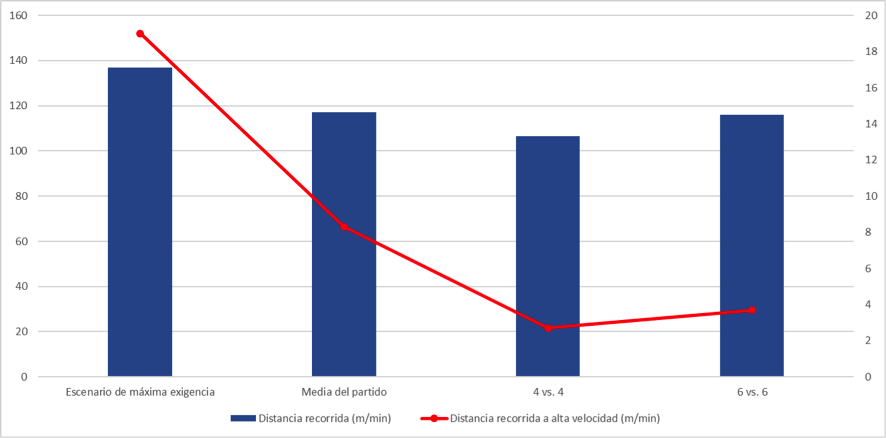March 11, 2019
Performance
Sports Performance
Team Sports
ARE SMALL-SIDED GAMES THE SOLUTION TO ALL OUR PROBLEMS?
One of today’s most attention-grabbing topics among sports researchers, coaches and managers have to do with the study of maximal demand scenarios, also known as “worst case scenarios”. In recent years, we’ve seen a number of new studies that describe the demands of competition in different sports – with a particular focus on these moments of maximal activity (Martín-García et al., 2018). Recently, an article was published in the International Journal of Strength and Conditioning Research in which the authors compare the activity of these maximal demand scenarios during competition, with the average demands of two very common training tasks currently in use: 4 vs. 4 situations in a 39 x 39 m space (152 m2 per player) and 6 vs. 6 situations in a 47 x 43 m space (144 m2 per player), both of which include goalkeepers as part of the exercise. During the games that were analyzed, an average match value was obtained for each of the physical variables studied. In addition, the highest value was obtained via the Rolling average method over 5-minute periods. The results of the study show how these types of training situations – in terms of distance covered per minute – do not reach the values for the maximal demand scenario within an actual match (137.0 ± 9.9 m·min-1). They show values close to those obtained for the match average (match average = 117.2 ± 8.6 m·min-1; 115.9 ± 8.9 and 106.4 ± 11.4 m·min-1 in 4 vs. 4 and 6 vs. 6, respectively). These differences between match demand (peak and average) and the training task demands are maximized when we analyze runs performed at high speed (>19.8 km·h-1) and at a sprint (>25.2 km·h-1). However, these short-sided game situations do appear to replicate the demands of the maximum demand scenarios in actual competition with respect to accelerations·min-1 and player load·min-1, with higher values in the smaller format (4 vs. 4 + goalkeepers in 39 x 39 m). Furthermore, in both training situations, the values obtained exceed those obtained in the match average, both in terms of the acceleration variable as well as player load per minute.

Therefore, as it has been demonstrated in previous studies, these types of training tasks do not appear to allow players experience situations close to those demanded by official matches in terms of total distance covered and runs performed at high speed and at a sprint. Given that much literature has emerged in recent years supporting the need to include sprint stimuli in an athlete’s preparation with the objective of minimizing injury risk (Malone et al., 2018), it seems appropriate to supplement training with other types of practices. Furthermore, as we seek to optimize our players’ state of physical conditioning, it seems necessary to include stimuli that approach or even exceed the demands of competition. As such, it is appropriate to include other types of tasks in addition to those proposed by the researchers responsible for this study. Playing situations with larger spatial dimensions (Castellano and Casamichana, 2016), finishing situations involving few players and a large space (Ade et al., 2014), analytical situations focused on intermittent running (Lacome et al., 2018), or repeat sprints (Rodríguez-Fernández et al., 2017) may be alternatives in this process of optimizing the players’ state of physical conditioning.
David Casamichana
References
Ade, J.D., Harley, J.A., & Bradley, P.S. (2014). Physiological response, time-motion characteristics, and reproducibility of various speed-endurance drills in elite youth soccer players: small-sided games versus generic running. Int J Sports Physiol Perform, 9(3):471-9.
Castellano, J. and Casamichana, D. (2016). El arte de planificar en fútbol. Futboldelibro.
Dalen, T., Sandmæl, S., Stevens, T.G.A., Hjelde, G.H., Kjøsnes, T.N., & Wisløff, U. (2019). Differences in Acceleration and High-Intensity Activities Between Small-Sided Games and Peak Periods of Official Matches in Elite Soccer Players. J Strength Cond Res, DOI: 10.1519/JSC.0000000000003081. [Epub ahead of print]
Lacome, M., Simpson, B.M., Cholley, Y., Lambert, P., & Buchheit, M. (2018). Small-Sided Games in Elite Soccer: Does One Size Fit All? Int J Sports Physiol Perform, 1;13(5):568-576.
Malone, S., Owen, A., Mendes, B., Hughes, B., Collins, K., & Gabbett, T.J. (2018). High-speed running and sprinting as an injury risk factor in soccer: Can well-developed physical qualities reduce the risk? J Sci Med Sport. 2018 Mar;21(3):257-262.
Martín-García, A., Casamichana, D., Díaz, A.G., Cos, F., & Gabbett, T.J. (2018). Positional Differences in the Most Demanding Passages of Play in Football Competition. J Sports Sci Med. 2018 Nov 20;17(4):563-570.
Rodríguez-Fernández, A., Sánchez Sánchez, J., Rodríguez-Marroyo, J.A., Casamichana, D., & Villa, J.G. (2017). Effects of 5-week pre-season small-sided-game-based training on repeat sprint ability. J Sports Med Phys Fitness, 57(5):529-536. ¡
KNOW MORE
CATEGORY: MARKETING, COMMUNICATION AND MANAGEMENT
This model looks to the future with the requirements and demands of a new era of stadiums, directed toward improving and fulfilling the experiences of fans and spectators, remembering “feeling” and “passion” when designing their business model.
CATEGORY: FOOTBALL SPORTS PERFORMANCE
Through the use of computer vision we can identify some shortcomings in the body orientation of players in different game situations.
CATEGORY: MEDICINE HEALTH AND WELLNESS
A health check must detect situations which, despite not showing obvious symptoms, may endanger athletes subject to the highest demands.
CATEGORY: FOOTBALL TEAM SPORTS
In the words of Johan Cruyff, “Players, in reality, have the ball for 3 minutes, on average. So, the most important thing is: what do you do during those 87 minutes when you do not have the ball? That is what determines whether you’re a good player or not.”
CATEGORY: MEDICINE HEALTH AND WELLNESS SPORTS PERFORMANCE
Muscle injuries account for more than 30% of all injuries in sports like soccer. Their significance is therefore enormous in terms of training sessions and lost game time.
DO YOU WANT TO KNOW MORE?
- SUBSCRIBE
- CONTACT
- APPLY
KEEP UP TO DATE WITH OUR NEWS
Do you have any questions about Barça Universitas?
- Startup
- Research Center
- Corporate